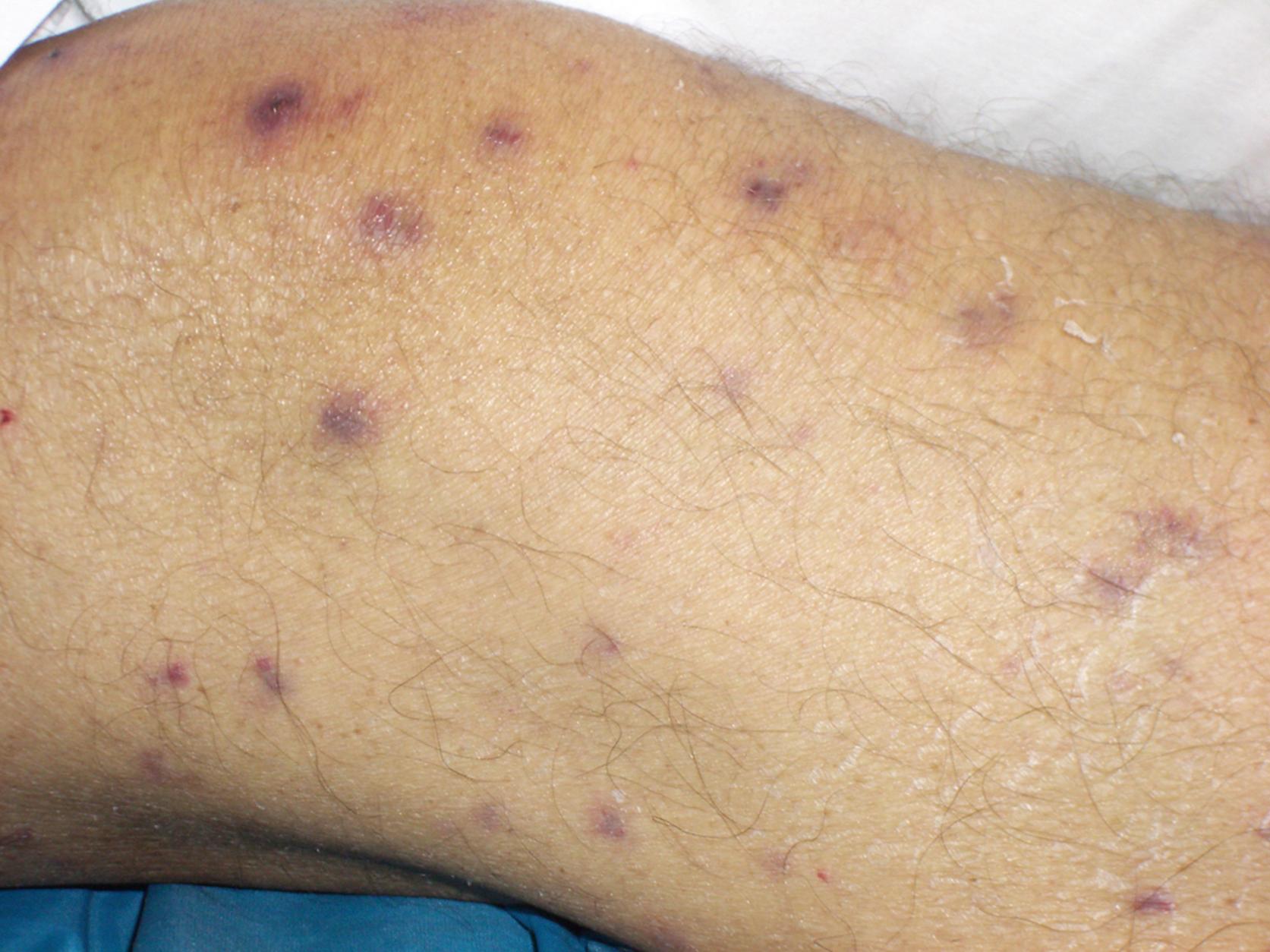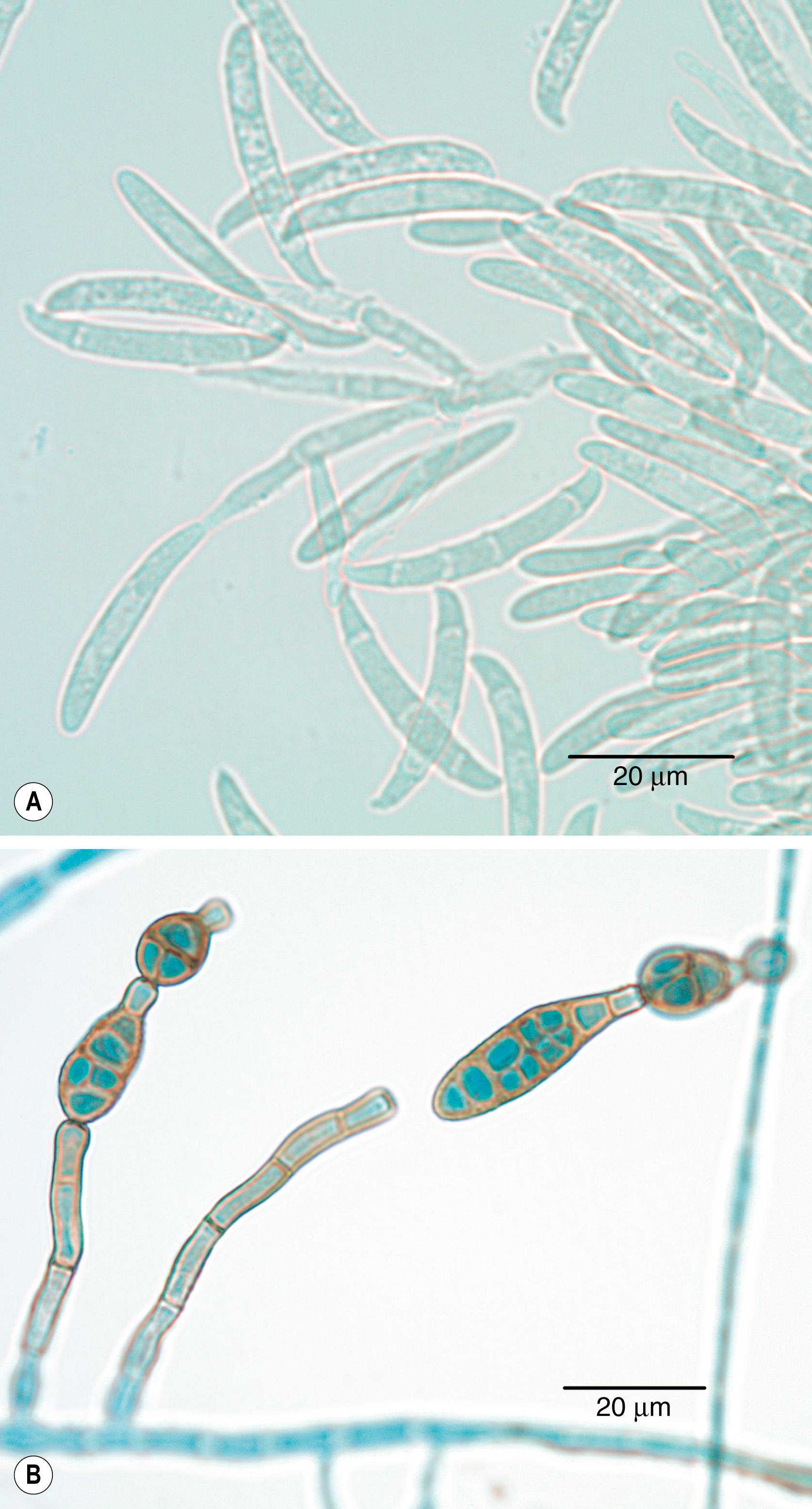Physical Address
304 North Cardinal St.
Dorchester Center, MA 02124
Agents of hyalohyphomycosis and phaeohyphomycosis are ubiquitous filamentous molds. (Moulds is the preferred spelling by many mycologists.) These molds are soil saprobes and plant pathogens that have gained notoriety as emerging pathogens in immunocompromised hosts, including children. The pathogenesis of infections with these organisms is not clearly established because many of these organisms are minimally pathogenic in humans. However, fungal conidia can cause infection in severely immunocompromised children, frequently in the paranasal sinuses or lungs, as a result of inhalation of aerosolized conidia. , Some of these organisms (e.g., Fusarium spp.) also can gain entry through the gastrointestinal tract, central venous catheters, or skin. , Direct inoculation of these organisms into tissues following trauma can lead to infection in both immunocompromised as well as immunocompetent children.
Agents of hyalohyphomycosis are a diverse group of molds whose tissue form is hyaline. Colonies can be of various colors or lightly pigmented. The most important of these organisms is Aspergillus (see Chapter 244 ), but other molds, such as Fusarium species, Scedosporium , Chrysosporium species, Penicillium species, Paecilomyces, and others, also cause infection in severely immunosuppressed children. These organisms resemble each other and Aspergillus in tissue; culture is needed to confirm the specific agent causing the disease. , As with other fungi, molecular and phenotypic studies have resulted in taxonomic changes in these molds; as a result, many molds are reported clinically as a species complex (e.g., Scedosporium apiospermum species complex, Fusarium solani , F. oxysporum species complexes, etc.), which can contain a large number of distinct species. The risk factors for these infections include significant immunosuppression such as immunosuppression associated with hematopoietic stem cell transplantation or bone marrow transplantation, profound neutropenia, malignant disease, and inherited immunodeficiencies. , Specific genetic deficiencies also have been identified that increase risk for infections with these organisms, which can begin in early childhood. An autosomal recessive mutation leading to CARD9 deficiency which is primarily expressed on myeloid cells has downstream impact on C-type lectin receptors that can recognize fungal components. Infections due to fungi from the phylum Ascomycota including hyalohyphomycoses and phaeohyphomycoses have been reported.
Increasing numbers of agents of hyalohyphomycosis have been reported to cause invasive mycoses in severely immunosuppressed children. , The epidemiology and risk factors for infection with these agents are similar to those associated with Aspergillus, and the clinical presentations of these infections are similar to manifestations of invasive aspergillosis. , Clinical presentations include sinusitis, pulmonary infection, localized abscesses, cutaneous infection, and disseminated infection. Some of these infections have characteristic epidemiologic features, including infection with Fusarium species, which has been associated with inhalation of contaminated aerosols from hospital water as well as infection following a primary paronychial or skin infection. , , In 2006, 164 confirmed cases of Fusarium keratitis were reported in wearers of soft contact lenses, and these infections led to corneal transplantation in 34%. , In a case-control study, cases were associated with use of a contact lens solution, although Fusarium was not found in unopened bottles. Although not common, Fusarium infections have been reported in children with hematologic malignancies just as they have been in adults. Scedosporium infections have been reported in patients after an episode of near drowning. , ,
Fusarium infections are among the most common of these agents, causing a spectrum of disease: toxin-mediated (mycotoxin syndrome), locally invasive, catheter-related, allergic bronchopulmonary, and disseminated infection. Toxin-mediated disease results from ingestion of contaminated grains. Symptoms range from mild gastroenteritis to bone marrow suppression resulting in aplasia and eventual death. Locally invasive diseases include mycotic keratitis, endophthalmitis, sinusitis, brain abscess, cystitis, cutaneous and subcutaneous infections, and paronychial and ungual infections. , , Penetrating trauma has been associated with osteomyelitis and pyogenic arthritis. Locally invasive infections can occur in immunocompetent and immunocompromised hosts.
Disseminated fusariosis, which is limited to immunocompromised hosts, especially hosts with a hematologic malignant disease or hematopoietic stem cell transplantation, is characterized by fungemia, skin lesions, and multiple organ involvement. , Fungemia is detected in 50%–60% of patients with a diagnosis of disseminated infection, and Fusarium is the only mold commonly associated with fungemia. Skin lesions are macular or papular, often with a necrotic center, and they occur predominantly on extremities and are characteristic of this infection ( Fig. 245.1 ). , , Disseminated fusariosis is often fatal; mortality rates between 60% and 100% are reported despite antifungal therapy, although improved rates of mortality have been reported since 2005. , ,

The S. apiospermum species complex consists of the closely related species S. apiospermum , S. boydii , S. ellipsoideum and S. angustum and S. fusoideum. , , Scedosporium apiosperum and S. boydii species were previously considered to be the same species, with S. apiospermum being the asexual form (anamorph) and Pseudallescheria boydii being the sexual form (teleomorph). However, through phylogenetic analysis, it is now recognized that S. apiospermum and S. boydii (previously also referred to by the teleomorph name P. boydii ) are indeed distinct species. Other sibling or cryptic species that are morphologically identical include S. aurantiacum, S. cereisporum, S. dehoogii, S. minutisporum, and S. desertorum . In tissue, hyaline, septate hyphae of Scedosporium resemble Aspergillus species. In immunocompetent hosts, these are major causes of fungal mycetoma, but in immunosuppressed hosts, widely disseminated infection occurs, including involvement of the brain. These organisms can be resistant to amphotericin B, with variable activity of extended spectrum azoles, voriconazole and posaconazole, shown in adults and children.
Clinical manifestations of other hyalohyphomycoses are not distinctive and mimic those of invasive aspergillosis, including pulmonary infection, sinus infection, central nervous system disease, osteomyelitis, and locally invasive infections (e.g., keratitis and skin and soft tissue infections). Rare hyalophyphomycoses such as Paecilomyces, Penicillium, Purpureocillium lilacinum, Acremonium, and others occasionally are isolated from clinical infections in children.
In tissue, all these organisms appear as branched, septated hyphae that are indistinguishable from hyphae of Aspergillus and other hyaline molds. Specific diagnosis requires isolation of the organism from culture of tissue ( Fig. 245.2A ). Some of these organisms are resistant to amphotericin B clinically and in vitro, including Fusarium and Scedosporium, with increased susceptibility reported to the newer azole agents, voriconazole and posaconazole. , Blood cultures can be useful in Fusarium, but results are rarely positive with infection caused by other agents of hyalohyphomycosis. Serologic testing and nonculture-based methods such as polymerase chain reaction tests for these agents are not available commercially.

Because some of these organisms, including Fusarium and Scedosporium, are resistant to amphotericin B, responses to amphotericin B are poor, although successful outcomes with the use of lipid formulations of amphotericin B have been reported. , , Posaconazole and voriconazole have been used with success in the treatment of both Scedosporium and Fusarium infections and are the likely drugs of choice for the agents of hyalohyphomycosis. , , Susceptibility to isavuconazole varies. With the use of voriconazole and liposomal amphotericin, better survival rates are being reported. Similar responses have been reported with the salvage use of posaconazole. Itraconazole also has activity against many of these organisms, but because of variable bioavailability, the role of itraconazole is limited to children with less severe infection. Antifungal agents to prevent these mycoses are not specifically indicated because infection is rare, although prophylaxis with posaconazole has been shown to reduce Aspergillus infections and would presumably prevent the emergence of infections with these mycoses as well. ,
Become a Clinical Tree membership for Full access and enjoy Unlimited articles
If you are a member. Log in here